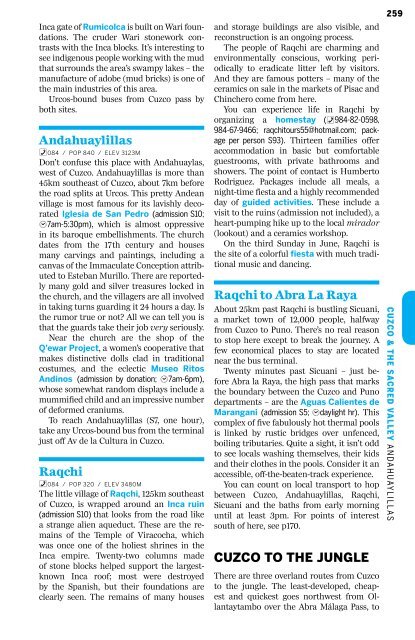peru-8-cuzco-sacred-valley
You also want an ePaper? Increase the reach of your titles
YUMPU automatically turns print PDFs into web optimized ePapers that Google loves.
Inca gate of Rumicolca is built on Wari foundations.<br />
The cruder Wari stonework contrasts<br />
with the Inca blocks. It’s interesting to<br />
see indigenous people working with the mud<br />
that surrounds the area’s swampy lakes – the<br />
manufacture of adobe (mud bricks) is one of<br />
the main industries of this area.<br />
Urcos-bound buses from Cuzco pass by<br />
both sites.<br />
Andahuaylillas<br />
%084 / POP 840 / ELEV 3123M<br />
Don’t confuse this place with Andahuaylas,<br />
west of Cuzco. Andahuaylillas is more than<br />
45km southeast of Cuzco, about 7km before<br />
the road splits at Urcos. This pretty Andean<br />
village is most famous for its lavishly decorated<br />
Iglesia de San Pedro (admission S10;<br />
h7am-5:30pm), which is almost oppressive<br />
in its baroque embellishments. The church<br />
dates from the 17th century and houses<br />
many carvings and paintings, including a<br />
canvas of the Immaculate Conception attributed<br />
to Esteban Murillo. There are reportedly<br />
many gold and silver treasures locked in<br />
the church, and the villagers are all involved<br />
in taking turns guarding it 24 hours a day. Is<br />
the rumor true or not? All we can tell you is<br />
that the guards take their job very seriously.<br />
Near the church are the shop of the<br />
Q’ewar Project, a women’s cooperative that<br />
makes distinctive dolls clad in traditional<br />
costumes, and the eclectic Museo Ritos<br />
Andinos (admission by donation; h7am-6pm),<br />
whose somewhat random displays include a<br />
mummified child and an impressive number<br />
of deformed craniums.<br />
To reach Andahuaylillas (S7, one hour),<br />
take any Urcos-bound bus from the terminal<br />
just off Av de la Cultura in Cuzco.<br />
Raqchi<br />
%084 / POP 320 / ELEV 3480M<br />
The little village of Raqchi, 125km southeast<br />
of Cuzco, is wrapped around an Inca ruin<br />
(admission S10) that looks from the road like<br />
a strange alien aqueduct. These are the remains<br />
of the Temple of Viracocha, which<br />
was once one of the holiest shrines in the<br />
Inca empire. Twenty-two columns made<br />
of stone blocks helped support the largestknown<br />
Inca roof; most were destroyed<br />
by the Spanish, but their foundations are<br />
clearly seen. The remains of many houses<br />
and storage buildings are also visible, and<br />
reconstruction is an ongoing process.<br />
The people of Raqchi are charming and<br />
environmentally conscious, working periodically<br />
to eradicate litter left by visitors.<br />
And they are famous potters – many of the<br />
ceramics on sale in the markets of Pisac and<br />
Chinchero come from here.<br />
You can experience life in Raqchi by<br />
organizing a homestay (%984-82-0598,<br />
984-67-9466; raqchitours55@hotmail.com; package<br />
per person S93). Thirteen families offer<br />
accommodation in basic but comfortable<br />
guestrooms, with private bathrooms and<br />
showers. The point of contact is Humberto<br />
Rodriguez. Packages include all meals, a<br />
night-time fiesta and a highly recommended<br />
day of guided activities. These include a<br />
visit to the ruins (admission not included), a<br />
heart-pumping hike up to the local mirador<br />
(lookout) and a ceramics workshop.<br />
On the third Sunday in June, Raqchi is<br />
the site of a colorful fiesta with much traditional<br />
music and dancing.<br />
Raqchi to Abra La Raya<br />
About 25km past Raqchi is bustling Sicuani,<br />
a market town of 12,000 people, halfway<br />
from Cuzco to Puno. There’s no real reason<br />
to stop here except to break the journey. A<br />
few economical places to stay are located<br />
near the bus terminal.<br />
Twenty minutes past Sicuani – just before<br />
Abra la Raya, the high pass that marks<br />
the boundary between the Cuzco and Puno<br />
departments – are the Aguas Calientes de<br />
Marangani (admission S5; hdaylight hr). This<br />
complex of five fabulously hot thermal pools<br />
is linked by rustic bridges over unfenced,<br />
boiling tributaries. Quite a sight, it isn’t odd<br />
to see locals washing themselves, their kids<br />
and their clothes in the pools. Consider it an<br />
accessible, off-the-beaten-track experience.<br />
You can count on local transport to hop<br />
between Cuzco, Andahuaylillas, Raqchi,<br />
Sicuani and the baths from early morning<br />
until at least 3pm. For points of interest<br />
south of here, see p170.<br />
CUZCO TO THE JUNGLE<br />
There are three overland routes from Cuzco<br />
to the jungle. The least-developed, cheapest<br />
and quickest goes northwest from Ollantaytambo<br />
over the Abra Málaga Pass, to<br />
259<br />
Cuzco & the Sacred Valley C T A H N u E zC DA H O H I K UAY TO E T L H I L E L A J U S N G L E


